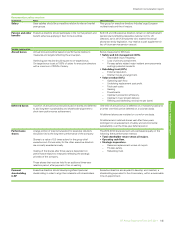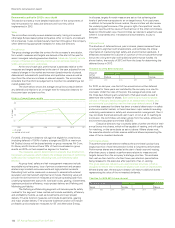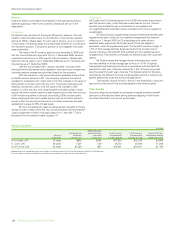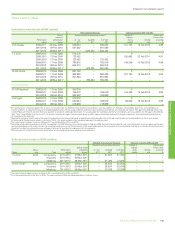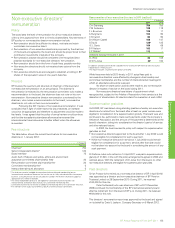BP 2011 Annual Report Download - page 144
Download and view the complete annual report
Please find page 144 of the 2011 BP annual report below. You can navigate through the pages in the report by either clicking on the pages listed below, or by using the keyword search tool below to find specific information within the annual report.
Directors’ remuneration report
142 BP Annual Report and Form 20-F 2011
Executive directors’ remuneration
Remuneration committee
During the year the committee met seven times, and was made up of the
following independent non-executive directors:
Mr Antony Burgmans (chairman from 2011 Annual General Meeting (AGM))
Mr George David
Mr Ian Davis
Dr DeAnne Julius was chairman of the committee until her retirement at
the 2011 AGM. Mr Svanberg has attended all meetings.
The group chief executive is consulted on matters relating to the other
executive directors and senior executives who report to him and on
matters relating to the performance of the company; neither he nor the
chairman of the board participate in decisions on their own remuneration.
The committee’s tasks are set out in the board governance principles:
• To determine, on behalf of the board, the terms of engagement and
remuneration of the group chief executive and the executive directors
and to report on these to the shareholders.
• To determine, on behalf of the board, matters of policy over which the
company has authority regarding the establishment or operation of
the company’s pension schemes of which the executive directors are
members.
• To nominate, on behalf of the board, any trustees (or directors of
corporate trustees) of such schemes.
• To review and approve the policies and actions being applied by the
group chief executive in remunerating senior executives other than
executive directors to ensure alignment and proportionality.
• To recommend to the board the quantum and structure of remuneration
for the chairman of the board.
The committee operates with a high level of independence. The board
considers all committee members to be independent (see page 121). They
have no personal financial interest, other than as shareholders, in the
committee’s decisions. Each member of the remuneration committee is
subject to annual re-election as a director of the company.
Gerrit Aronson, an independent consultant, is the committee’s
independent adviser as well as secretary. He is engaged directly by the
committee and not by executive management. Advice is also received
from David Jackson, the company secretary, and from the company
secretary’s office, which is independent of executive management and
reports to the chairman of the board.
The committee also appoints external advisers to provide specialist advice
and services on particular remuneration matters. The independence of
the advice is subject to periodic review. In 2011, the committee continued
to engage Towers Watson as its principal external adviser, primarily for
market information. Towers Watson also provided other remuneration and
benefits advice to parts of the group. Freshfields Bruckhaus Deringer LLP
provided legal advice on specific matters to the committee, as well as
providing some legal advice to the group.
The committee values its dialogue with major shareholders
on remuneration matters. The committee is accountable to shareholders
through its annual report on executive directors’ remuneration. It will
consider the outcome of the vote at the AGM on the directors’
remuneration report and take into account the views of shareholders in its
future decisions.
Executive directors’ remuneration 2011
This section contains detail on executive directors’ remuneration including
salary, annual bonus and deferred bonus relating to 2011 and the share
element for the performance period 2009-2011.
Salary
Mr Dudley’s current salary of $1,700,000 was unchanged during 2011.
As reported in last year’s remuneration report, Mr Conn’s and Dr Grote’s
salaries were increased in April 2011 to £730,000 and $1,442,000
respectively, their first increase since 2008.
Annual bonus
Framework
All executive directors were eligible for an overall annual bonus, including
deferral, of 150% of salary at target and a maximum of 225% of salary.
Mr Dudley’s annual bonus was based entirely on group results and
Mr Conn’s and Dr Grote’s based 70% on group results and 30% on their
respective segment and function.
Measures and targets for the annual bonus were set at the start of
the year and were derived from the company’s annual plan which, in turn,
reflected its strategic priorities of reinforcing safety and risk management,
rebuilding trust and reinforcing value creation. Targets are set so that
meeting plan equates to on-target bonus.
At group level, the safety and risk management component
included targets for recordable injury frequency, loss of primary
containment and implementation of change programmes. Rebuilding trust
was focused on external reputation as measured by external surveys and
internal morale as measured by surveys. Finally, the value component
included measures for underlying replacement cost profit, total cash
costs, upstream operating cash and downstream profitability.
Mr Conn’s Refining and Marketing segment similarly included
targets for various safety measures, onstream availability, cost efficiency
and profitability. Dr Grote’s functional segment included measures for IST
compliance, succession and divestments.
Apart from the specific measures set out, the committee may
consider any other results that it deems relevant and apply its judgement
in determining final bonus scores.
Results
Outcomes for the year are summarized in the table below, with a more
detailed explanation following.
2011 bonus measures and outcomes
Key measures for 2011 bonus
Safety and risk management
Below target On target Better than
target
Recordable injury frequency
Loss of primary containment
Implementation of change
programmes
Retaining and building capability
Rebuilding trust
External reputation
Internal alignment and morale
Restoring value
Underlying replacement cost profit
Total cash costs
Upstream operating cash
Refining and Marketing profitability















